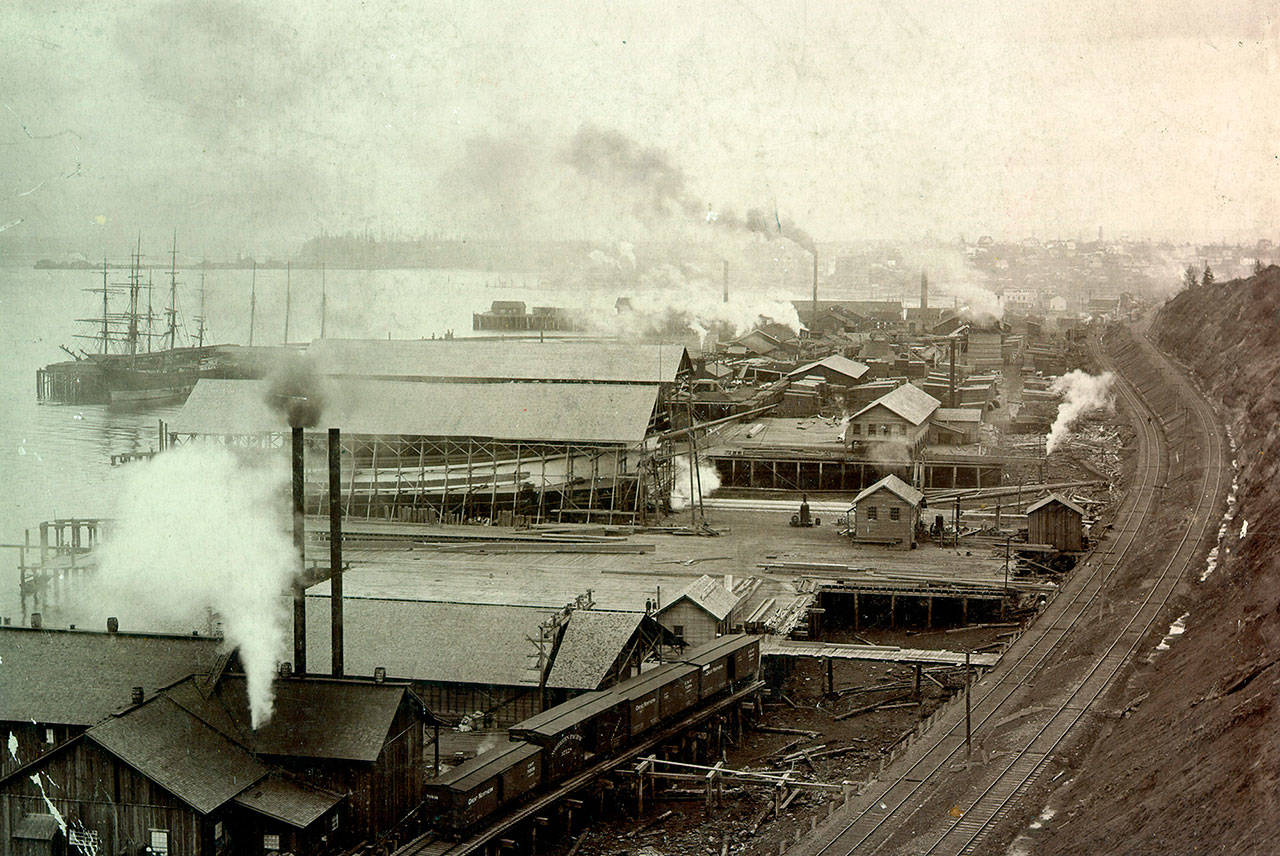This is one of a collection of stories marking the Port of Everett’s 100th anniversary in July.
EVERETT — The Port of Everett is the offspring of “controversial legislation” approved by Washington lawmakers — the Port District Act of 1911.
At the dawn of the 20th century, public ownership of port facilities, such as harbors, docks and waterfront properties, was a “radical and controversial” idea — on par with giving women the right to vote and workers the right to organize, according to Kit Oldham, senior editor at HistoryLink.org, an online encyclopedia.
The Port of Everett — which celebrates its 100th anniversary this month — and other Washington ports can trace their genesis to the 1911 law.
Under the law, citizens of any county could vote to form a port district, which had the power to issue bonds, set dock rates, levy taxes with voter approval and acquire property by eminent domain.
Then, as now, citizens elected three commissioners to govern.
It was a bold move by lawmakers to wrest “control of the waterfront” from private companies that used it to further their their gains “rather than promote trade and make it easier for the area’s merchants and farmers to import and export goods,” Oldham writes.
The port’s structure — an independent government entity with elected commissioners responsible for securing the public interest — was “novel at the time and remains unique today,” Oldham argues. Ports “in other states are still generally run as departments of city or state government,” with appointed commissioners.
Taking the lead, the Port of Seattle established itself in June 1911. The Port of Grays Harbor and the Port of Vancouver followed. There are now 75 public ports in the state, in 33 of the 39 counties.
In 1918, Everett citizens hoping to capture a piece of World War I’s industry, voted overwhelmingly to create a port district and set boundaries.
Then, as now, the desire was to “reclaim the waterfront from private industry, protect the interests of the residents, create family-wage jobs and serve as the waterfront’s steward,” said Lisa Lefeber, the port’s acting chief executive.
In 1919, the Port of Everett drafted its first harbor plan and presented it to the public via newspapers and hearings — one of the law’s many requirements ensuring an open process.
In the decades to follow, the port shaped the city like no other entity in a quest to create jobs by creating opportunities for others to make money.
For example, a business could lease a space at the port to sell and repair boats or operate a restaurant. The port also makes money running its natural deep-water cargo port and collecting fees from boat owners whose vessels are berthed at the largest public marina on the West Coast.
In the early years, wood products produced by Everett waterfront mills dominated the economy.
“Everett was a mill town from about 1900 to the mid-1960s,” said Lawrence O’Donnell, who co-authored “The Evolution of a Vibrant Everett Waterfront: A Story of Sawdust, Salmon & Speedboats” with his brother, Jack O’Donnell. The book recounts port history and the impact of lumber, fishing and boat building on the region.
In 1910, Everett mills produced 6 million cedar shakes per day. Laid end-to-end, they’d stretch 1,400 miles, O’Donnell reckoned.
The mills supported sawyers, mill workers, saw filers, boat operators, dock workers, railroad workers and everyone in between, said O’Donnell, who once worked at the Weyerhaeuser mill on the Snohomish riverfront.
At some mills, workers were given an hour lunch break — to hurry up and eat and help sharpen the enormous band saws from 18 feet to 30 feet long and up to 5 inches wide. “When the weld broke on one of those things, the mill shook,” O’Donnell said.
In the 1960s, sales of composition roof shingles skyrocketed, sounding the death knell for the cedar shake industry.
“You could see it was the end because some of the mills had composition roofs,” O’Donnell quipped.
As luck would have it, the decline of the wood-product industry coincided with the arrival of The Boeing Co. in Everett and the manufacture of the 747 in the late 1960s, O’Donnell said.
The port now functions as an extension of the aerospace manufacturing process, accommodating 100 percent of the oversized aerospace parts and components for the 747, 767, 777 and 777X.
Handling oversize containers, along with industrial and agricultural equipment, has become the port’s niche, port spokeswoman Catherine Soper said.
Containers with clothing and consumer electronics are more likely to dock at the ports of Seattle and Tacoma, Soper said.
In 2008, the port’s Mount Baker Terminal in Mukilteo opened to accommodate parts for the 777.
In coming years, the modernization of seaport cargo facilities will enable the port to handle even larger containers carrying parts for the 777X.
Each of the port’s three business lines — the marina, the cargo port and real estate — are required to be self-supporting. That means they have to pay for themselves and employee salaries, Soper said.
However, the port levies property taxes to pay for environmental cleanup and capital improvements. This year’s port tax is about 27 cents per $1,000 of assessed value.
Taxing district lines were drawn up a century ago and have been expanded only once since — to include Hat Island. In 2011, district lines were shifted so that each now touches a waterfront community. The boundaries encompass most of Everett and parts of Mukilteo and adjacent unincorporated areas of Snohomish County.
Janice Podsada: jpodsada@heraldnet.com; 425-339-3097
Talk to us
> Give us your news tips.
> Send us a letter to the editor.
> More Herald contact information.

























